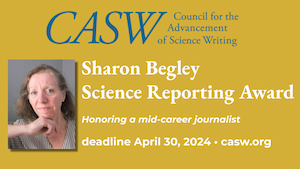By Sarah Zielinski
Jobs in science journalism at traditional media organizations are starting to return after their recession-driven decline, but these positions have emerged changed and much busier, said speakers at the ScienceWriters2012 session “Not dead yet: How science journalism is evolving at traditional news organizations” on October 27.
“The jobs are out there, and they’re increasing,” said Philip Hilts, director of the Knight Science Journalism Fellowship Program.
Session moderator Peggy Girshman, executive editor of Kaiser Health News, noted that science journalism is still strong at publications such as the New York Times and the Washington Post, as well as at NPR.
Hilts documented a dramatic increase in the number of freelancers applying to the Knight program during the recent recession, reflecting the loss of staff positions during that period. Staffers who went through the program often did not return to their previous jobs, instead turning to freelancing. But that balance of staff versus freelance has evened out more recently, Hilts has found, and more people are returning to staff positions after their time as a fellow.
These staff positions, however, have evolved. At the Wall Street Journal, for example, the number of people covering health and science has decreased by 40 percent or so, due to attrition and layoffs, said Ron Winslow, the Journal’s deputy editor for health and science. Long-form journalism has been cut in half. And the newspaper has expanded into digital platforms, bringing more change to reporters’ lives. But there’s still plenty of demand for science and health in the paper; these subjects “often get good play on A3,” Winslow says.
Elizabeth Pennisi, a writer for Science magazine, has also seen her job become altered. Because Science is an association magazine, it has been somewhat immune to changes in advertising and readership, but the publication has still had to weather budget cuts. A smaller budget for freelance contributions has put more pressure on staffers. “My job has gotten busier,” she said. Weekly deadlines have morphed into daily and even hourly deadlines. “My time is more fractional,” and there is now less time to write feature stories.
Science News magazine, published by the Society for Science & the Public, has undergone major changes in the last six years, associate editor Kate Travis said. In 2006, the magazine was a weekly 16-page publication with a basic website that had only content from the magazine. Today, Science News is a 32-page biweekly publication, with a website updated daily and a weekly iPad edition called SN Prime. The number of writers has changed little but there are now more than twice as many editors, and the magazine uses freelancers for features and departments, another new addition. As a result of the changes, writers are doing more. “There’s a lot more different types of content to divide their time,” Travis said.
Digital skills are becoming more important, but being able to write well is still the deciding factor when looking at potential new hires, said Girshman. “I care less about tweeting and more about writing.”
.png)

